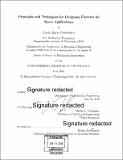| dc.contributor.advisor | Martin L. Culpepper. | en_US |
| dc.contributor.author | Countouris, Paula Marie | en_US |
| dc.contributor.other | Massachusetts Institute of Technology. Department of Mechanical Engineering. | en_US |
| dc.date.accessioned | 2018-10-22T18:47:23Z | |
| dc.date.available | 2018-10-22T18:47:23Z | |
| dc.date.copyright | 2018 | en_US |
| dc.date.issued | 2018 | en_US |
| dc.identifier.uri | http://hdl.handle.net/1721.1/118744 | |
| dc.description | Thesis: S.M., Massachusetts Institute of Technology, Department of Mechanical Engineering, 2018. | en_US |
| dc.description | Cataloged from PDF version of thesis. | en_US |
| dc.description | Includes bibliographical references (pages 87-90). | en_US |
| dc.description.abstract | Flexures play an important role in precision machine design for space by allowing accurate and repeatable motion through bending of compliant elements. The design of flexures is a non-trivial process due to the interconnection of the kinematics, mechanics, and dynamics. This thesis defines a framework within which existing tools may be used to better design flexures, provides a holistic perspective on the design process, and reviews best practices for space applications. The design process is separated into four main phases which align with the review phases of space programs: conceptual design, preliminary design, detailed design, and fabrication and validation. In the conceptual design phase, requirements, constraints, environments, and failure modes are identified and discussed. The preliminary design phase includes synthesis of the flexure geometry, initial modeling and analysis, and design considerations including choice of actuators, materials, and interfaces. The detailed design discusses modeling, simulation, analysis, and optimization techniques used in flexure design. The fabrication and validation phase compares common manufacturing techniques and includes information about assembly, testing types, and reworking options. Specific flexure design resources and techniques are described in each section including exact constraint design, and precision machine design. An example flexure design of a mirror mount demonstrates the use of this process. Use of the framework will improve performance, schedule, and reliability of existing technologies for space system designs and enable new capabilities. | en_US |
| dc.description.sponsorship | Sponsored by the Department of the Air Force Air Force contract #FA8721-05-0002 | en_US |
| dc.description.statementofresponsibility | by Paula Marie Countouris. | en_US |
| dc.format.extent | 90 pages | en_US |
| dc.language.iso | eng | en_US |
| dc.publisher | Massachusetts Institute of Technology | en_US |
| dc.rights | MIT theses are protected by copyright. They may be viewed, downloaded, or printed from this source but further reproduction or distribution in any format is prohibited without written permission. | en_US |
| dc.rights.uri | http://dspace.mit.edu/handle/1721.1/7582 | en_US |
| dc.subject | Mechanical Engineering. | en_US |
| dc.title | Principles and techniques for designing flexures for space applications | en_US |
| dc.type | Thesis | en_US |
| dc.description.degree | S.M. | en_US |
| dc.contributor.department | Massachusetts Institute of Technology. Department of Mechanical Engineering | |
| dc.identifier.oclc | 1057342029 | en_US |
